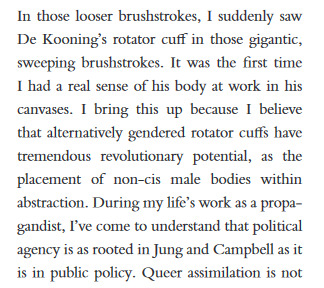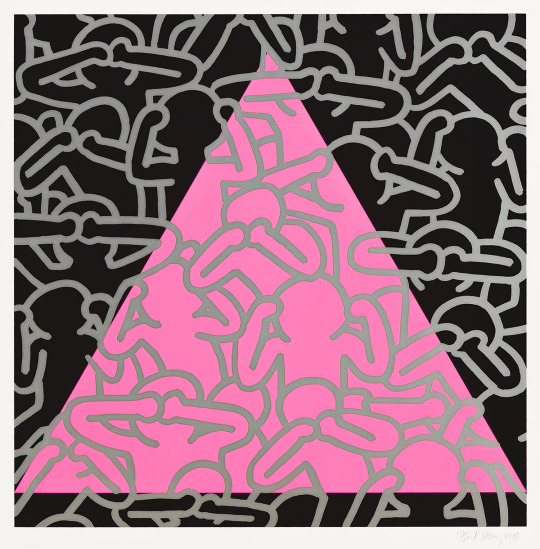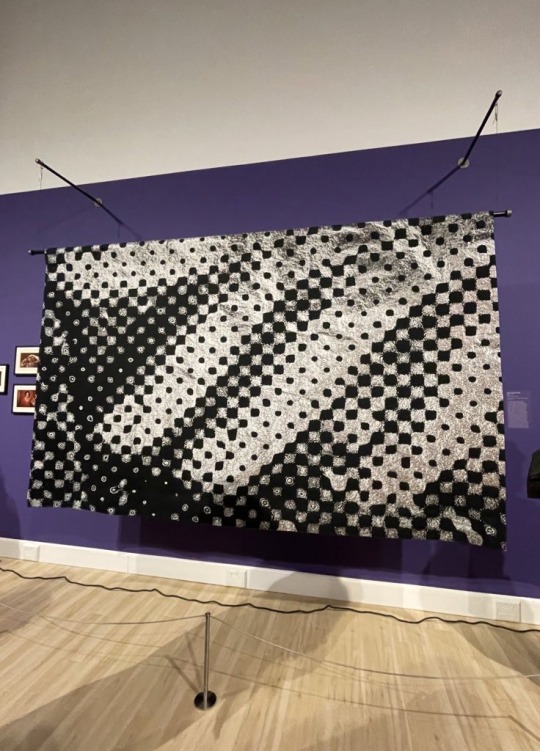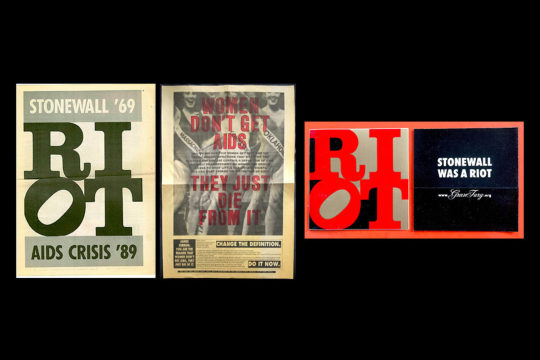#avram finkelstein
Explore tagged Tumblr posts
Photo

Avram Finkelstein
After a three-year delay, I finally had the honor to interview artist, activist and founding member of ACT UP and Gran Fury, Avram Finkelstein. Can’t think of a better way to wrap up one of the last days filming my Queer Street Art documentary, OUT IN THE STREETS.
Please support this film by making a 100% tax-deductible donation to OUT IN THE STREETS.
More Photos: Queer Street Art, Dusty Rebel Production
#dusty rebel production#queer street art#out in the streets#avram finkelstein#act up#gran fury#street art#portrait#documentary#queer art#lgbt#queer history#queer liberation
5 notes
·
View notes
Text
#out in jersey#out in jersey magazine#archive of activist art#new museum#nyc#art event#panel discussion#avram finkelstein#feature article#art and activism
0 notes
Text

The phrase "alternatively gendered rotator cuffs" is one of the most insane strings of words I've ever read. THEN, he follows it up with a sentence about the eminently cisgender freaks Jung and Campbell that I can't connect to anything that came before it.
#I don't think that Jung identified the trope of the patriarchal rotator cuff in the collective unconscious#I'm very sorry#blink twice if you are okay Avram Finkelstein#I like ur work from the years you were in ACT UP#so uh#yeah
1 note
·
View note
Text

1989 Keith Haring “Silence = Death” 152/200
Haring was able to leverage his celebrity to support causes and activist groups, like ACT UP, the AIDS Coalition to Unleash Power. The sale of his art and merchandise, was among the first of the organization's sources of fundraising. The present screenprint, Silence = Death, was created by Haring as a fundraiser for the Arts Outreach Fund for AIDS, using ACT UP's slogan and iconic pink triangle, which was originally used by the Nazis to identify and persecute homosexuals. The logo was created by the art collective, Silence = Death Project, co-founded by artist and activist Avram Finkelstein, in 1987 as a poster campaign. The logo was later donated to ACT UP, of which Finkelstein was also a founding member.
[source: Swann Galleries]
61 notes
·
View notes
Text










Do Not Be Silent
The Sound of Silence - Simon and Garfunkel
Silence = Death - Avram Finkelstein
A Litany for Survival - Audre Lorde
First They Came - Pastor Martin Niemöller
S!CK - The Warning
Tahar Djaout
The Heptameron - Marguerite de Navarre
Barbara Kruger
Song of Myself - Walt Whitman
Trust No Cop - Ludlow
{Image descriptions in alt text}
#silence#web weaving#simon and garfunkel#silence=death#act up#aids crisis#audre lorde#martin niemöller#the warning#tahar djaout#marguerite de navarre#the heptameron#barbara kruger#walt whitman#ludlow#acab#aesthetic#lgbt#queer
8 notes
·
View notes
Text

“I Hate Straights” - Published in 1990, written by Avram Finkelstein and David Robinson. From the book “Queers Read This”, a collection of the best queer liberation essays of the era.
transcript: I have friends. Some of them are straight.
Year after year, I see my straight friends. I want to see them, to see how they are doing, to add newness to our long and complicated histories, to experience some continuity.
Year after year I continue to realize that the facts of my life are irrelevant to them and that I am only half listened to, that I am an appendage to the doings of a greater world, a world of power and privilege, of the laws of installation, a world of exclusion.
"That's not true," argue my straight friends. There is the one certainty in the politics of power: those left out of it beg for inclusion, while the insiders claim that they already are. Men do it to women, whites do it to blacks, and everyone does it to queers.
The main dividing line, both conscious and unconscious, is procreation ... and that magic word - Family. Frequently, the ones we are born into disown us when they find out who we really are, and to make matters worse, we are prevented from having our own. We are punished, insulted, cut off, and treated like seditionaries in terms of child rearing, both damned if we try and damned if we abstain. It's as if the propagation of the species is such a fragile directive that without enforcing it as if it were an agenda, humankind would melt back into the primeval ooze.
I hate having to convince straight people that lesbians and gays live in a war zone, that we're surrounded by bomb blasts only we seem to hear, that our bodies and souls are heaped high, dead from fright or bashed or raped, dying of grief or disease, stripped of our personhood.
I hate straight people who can't listen to queer anger without saying "hey, all straight people aren't like that. I'm straight too, you know," as if their egos don't get enough stroking or protection in this arrogant, heterosexist world. Why must we take care of them, in the midst of our just anger brought on by their f---ed up society?! Why add the reassurance of "Of course, I don't mean you. You don't act that way." Let them figure out for themselves whether they deserve to be included in our anger.
But of course that would mean listening to our anger, which they almost never do. They deflect it, by saying "I'm not like that" or "now look who's generalizing" or "You'll catch more flies with honey ... " or "If you focus on the negative you just give out more power" or "you're not the only one in the world who's suffering." They say "Don't yell at me, I'm on your side" or "I think you're overreacting" or "Boy, you're bitter."
- Let Yourself Be Angry
They've taught us that good queers don't get mad. They've taught us so well that we not only hide our anger from them, we hide it from each other. We even hide it from ourselves. We hide it with substance abuse and suicide and overachieving in the hope of proving our worth. They bash us and stab us and shoot us and bomb us in ever increasing numbers and still we freak out when angry queers carry banners or signs that say Bash Back. For the last decade they let us die in droves and still we thank President Bush for planting a f---ing tree, applaud him for likening PWAs to car accident victims who refuse to wear seatbelts. Let yourself be angry. Let yourself be angry that the price for visibility is the constant threat of violence, anti-queer violence to which practically every segment of this society contributes. Let yourself feel angry that there is no place in this country where we are safe, no place where we are not targeted for hatred and attack, the self-hatred, the suicide - of the closet.
The next time some straight person comes down on you for being angry, tell them that until things change, you don't need any more evidence that the world turns at your expense. You don't need to see only hetero couple grocery shopping on your TV ... You don't want any more baby pictures shoved in your face until you can have or keep your own. No more weddings, showers, anniversaries, please, unless they are our own brothers and sisters celebrating. And tell them not to dismiss you by saying "You have rights," "You have privileges," "You are overreacting," or "You have a victim's mentality." Tell them "Go away from me, until you change." Go away and try on a world without the brave, strong queers that are its backbone, that are its guts and brains and souls. Go tell them go away until they have spent a month walking hand in hand in public with someone of the same sex. After they survive that, then you'll hear what they have to say about queer anger. Otherwise, tell them to shut up and listen.
#i hate straights#queers read this#leftist#90s#history#queer community#queer pride#queer liberation#gay#lesbian#transgender#bisexual#liberation#essays#theory#lgbtqia#lgbtq community#lgbt pride#trans pride#pride#gay pride
5 notes
·
View notes
Text




“As the World Burns: Queer Photography and Nightlife in Boston,” SMFA: Tufts, opening night.
Photo 1: Avram Finkelstein (b. 1952) Untitled. Wool, cotton, and Lurex. Commissioned by The Shed in New York City in 2019, Avram Finkelstein's monumental jacquard weaving references his 1972 needlepoint portrait of his friend B. while incorporating other multifaceted source material, such as a digital iPhone manipulation of B.'s hand from one of Nan Goldin's photographs superimposed on photos of the hands of Finkelstein and David Armstrong. In manufacturing textiles through sequenced punch cards, the early nineteenth-century Jacquard machine led to more advanced computing hardware and eventually digital media, like those the artist utilized to create the image adorning this tapestry. More than a paean to queer friendship, the work Invites speculation on social, technological, and linguistic shifts related to gender and representation since the advent of modernity -that is, long before the 1970s. Untitled, 1972 participates in a rich dialogue with As the World Burns (photo 3) Mark Winer's digitized film from 1973, since both are loving portraits of B. and her community.
Photo 2: Photographs of queer Boston by bartender Jim McGrath at famed bar Playland.
Photo 3: As the World Burns, Mark Winer’s queer parody of As The World Turns, shot 1973
Photo 3: Nan Photographing at The Other Side, Boston, 1973, photographed by Allen Frame
6 notes
·
View notes
Text
Silence = Death

Silence=Death is an LGBT slogan that gained popularity after the making of a protest poster. The project began with Avram Finkelstein, Jorge Socarras, Chris Lione, Charles Kreloff, Oliver Johnston, and Brian Howard in 1987 to raise awareness for AIDS. However, this source, which is equally unreliable, dates the beginning of the movement to 1986.
Along with the poster, this button is one of the famous relics of this organization, and I'm proud to say that I own one that my grandma gave me which she acquired during her time running the GLBT club at the high school she worked at.
The pink triangle was, at the time one of the primary symbols representing the queer community, and the slogan silence=death was directed at Ronald Reagan, who had largely been silent about the AIDS epidemic until later in 1987 when he declared it "public health enemy #1."
#queer#queer history#gay#gay history#lgbt#lgbt history#type: definition#silence = death#nyc collection
1 note
·
View note
Text
Queer|Art announces new mentors for 2024 Queer|Art|Mentorship program cycle
(Image credits, clockwise from top left: 1. Kate Bornstein, image by Jess Dugan; 2. Demian DinéYazhi’, image courtesy of the artist; 3. Jackie Ess, image courtesy of the artist; 4. Avram Finkelstein, image by Alina Oswald; 5. Eva Yaa Asantewaa, image by D. Feller; 6. Stephen Winter, image courtesy of the artist; 7. Ira Sachs, image courtesy of the artist; 8. M. Lamar, image courtesy of the…

View On WordPress
0 notes
Photo


#repost @avramf Avram Finkelstein (USA, 1952- ). Canine imagery in Finkelstein’s design for get-out-the-vote projects with support of @thec4aa. The group of flags for Float the Vote, a Detroit food and ice cream truck project to educate people about registration, early voting, and polling locations were printed by @marymackwear. More info at https://c4aa.org/2020/10/unstoppable-voters-projects
#dog#perro#chien#hund#hond#koira#hand shadow#shadow puppet#shadow animals#get out the vote#election#avram finkelstein#political art
1 note
·
View note
Link

Stonewall was a riot.
4 notes
·
View notes
Photo



In 1950s - 1960s, homosexuality was illegal in 49 states, and members of LGBTQ community were harassed, imprisoned, fined, and targeted for violence and discrimination. The Stonewall Inn on Christopher Street in New York City was a bar where gays, lesbians, and people with a wide range of gender identities gathered together and found refuge, though not without harassment. Police often raided the Stonewall and other gay bars and arrested patrons.
During the early morning of June 28, 1969, nine police officers raided the Stonewall Inn once again. Already fed up after decades of harassment, patrons resisted by pushing through barricades, throwing bottles, and finally, setting fire to the bar. Meanwhile, the crowd grew bigger outside the bar as the hours passed. Hundreds of people chanted “Gay Power,” “We Want Freedom,” and “We Shall Overcome.”
The uprising against unjust treatment and violence by police lasted until July 1st and marked a watershed moment for the LGBTQ rights movement. It sparked the establishment of the Gay Liberation Front, the first activist group to publicly advocate for gay rights.
June is Pride Month. We must remember this history, and continue educating people and fighting for equal rights for all people.
We also recommend the film, “Stonewall Uprising” on PBS:
Image 1: Cover with a jacket Image 2: Right: Sunil Gupta, “Untitled #8 from Christopher Street” 1976 Image 3: Left: Avram Finkelstein, “Journal Notes, Sketches for Posters” 1986, Right: “Silence=Death Project, Silence=Death” 1987
Art after Stonewall : 1969-1989 edited by Jonathan Weinberg with Tyler Cann, Anastasia Kinigopoulo, and Drew Sawyer. Published: Columbus, Ohio : CMOA, Columbus Museum of Art ; New York, New York : Rizzoli Electa, 2019. 304 pages : illustrations (some color), portraits, photographs ; 27 cm
Explores the impact of the lesbian, gay, bisexual, and transgender civil rights movement on the art world of the period. It focuses on openly LGBTQ artists like Nan Goldin, Harmony Hammond, Lyle Ashton Harris, Greer Lankton, Glenn Ligon, Robert Mapplethorpe, Catherine Opie, and Andy Warhol, as well as the practices of such artists as Diane Arbus, Jean-Michel Basquiat, and Karen Finley in terms of their engagement with queer subcultures.
English 2019 HOLLIS number: 99153771490003941
#stonewall#stonewall uprising#artafterstonewall#llgbtq#LGBTQIA#lgbtqartist#pridemonth#fineartslibrary#harvardfineartslib#harvardfineartslibrary#Harvard#harvard library#artandactivism#activismandart#lgbtqactivism#artforjustice#queerart#queer#queerhistory#lgbtqhistory
23 notes
·
View notes
Text
#tbt#cover story#interview#photography#world pride 2019#nyc pride 2019#pioneer works#published work#cover photography#art and activism#hiv and aids#lgbtqia#editorials#actup#what is 21st century liberation
3 notes
·
View notes
Note
Hi queer Jew here. I noticed your icon is a pink triangle and it worries me if you're not Jewish or Romani because reclaiming that symbol is uncomfortable otherwise. It's still shoah imagery and it makes queer Jews and Roma uncomfy when non Jews and non Roma try to reclaim it.
hi and hello thank you for reaching out to me it’s smth that i have had a lot of conversations with other queer people about and i always want to hear what other queer people think.
but i’m aware of the connotations and history behind the pink triangle. the inverted pink triangle was what was used in concentration camps and by the n*zi’s. the upward-pointing pink triangle, like what my icon is, was popularized / and used by the act up movement in the 80s / 90s.
“Avram Finkelstein is credited with designing the campaign’s pink triangle — which is right-side up, instead of the N*zi-era upside-down pink triangle — after conservative pundit William F. Buckley suggested that HIV/AIDS patients get tattoos to warn partners in a 1986 New York Times op-ed.” -(Times article on the history of the pink triangle)
obviously its impossible to separate the pink triangle from the holocaust, which was the intention, but it is my understanding that it was not just jewish and roma queer people that were persecuted but any person that was “identified” as queer. i think both the holocaust and the AIDS crisis are incredibly important aspects of queer history, which is actively erased and ignored and destroyed. my use of it is not an attempt to co-opt it from jewish and roma LGBTQ people but as a symbol that has been reclaimed by the queer community to raise awareness to the suffering and persecution of past generations of LGBTQ people, which is why i use the upwards pointing triangle.
if you want to talk off anon i’d be happy to talk to you more about it and hear your side. i also understand that it can make some LGBTQ people uncomfortable, just like the reclaiming of the word queer which also has a violent history though certainly not the same scale as the pink triangle and i respect why some people do not use it or would prefer it not be used. but it’s true that i am neither jewish not roma, and if you could explain more to me why it is something that non-jewish and non-roma people should not be using i would 100% be willing to listen
#nazi mention tw#holocaust mention tw#ask to tag#wow this got long#hope this doesen't come across as mansplaining#or smth#im just trying to explain my justifications behind my use of it#( asks : ooc )#Anonymous
4 notes
·
View notes
Photo



lecture w10 - art activism (content warning: aids crisis, institutionalised homophobia, n*zism)
i’m passionate about art + i’m passionate about social justice, so the focus of this week’s lecture on art activism was a win in my books !
i’ve actually found myself thinking about the connection between art and activism a lot recently - for my comm. design studies major project, i’m focusing on keith haring, an artist whose art advocated for many social issues. as well as this, our image and identity project operates in the area of political + social issues.
the ability of design and art to connect with social issues is something i want to continuously reflect in my own work. all three of the images i’ve included here aim to raise awareness about aids during the height of the aids crisis - this selection of images wasn’t strictly planned, but this post-stonewall queer culture did see the rise of a lot of political art calling for more awareness on the disease.
in particular, the work of six gay activists (avram finkelstein, brian howard, oliver johnston, charles kreloff, chris lione,+ jorge socarrás) and their creation of the silence=death poster and campaign (an interviewee i considered for my major project) is one of the most widely recognisable pieces of imagery associated with the aids crisis. the subversion of a nazi symbol used to label gay men in concentration camps is something truly potent - it’s this reclaiming of a symbol of hatred to unite which aimed to raise awareness about the aids crisis within the queer community.
similarly, keith haring used his platform as an artist to challenge the lack of public awareness about aids - for most of the early 80s, it was referred to the gay plague, or grid (gay related immune deficiency), and was literally laughed at by press secretary larry speakes at the white house under the reagan administration. and though it was identified in 1981 and had already killed hundreds of vulnerable americans, reagan himself did not say the word ‘aids’ until 1985.
as with the silence = death campaign, keith worked to stop public silence on aids, and to open conversations about safe sex and sex in the queer community as a whole, obviously a taboo topic. but through art and design, we can present activism in a new light, something which can easily be recognised and can say all we mean to through one symbol, or one motif, or one artwork. all three of the images here encourage the viewer to stop avoiding the issue, and, as all activism does, prompt social and political action.
[first image from lecture slides
second from this rlly insightful article https://nytimesineducation.com/loss-and-bravery-intimate-snapshots-from-the-first-decade-of-the-aids-crisis/
third from https://thequeerness.com/2016/02/05/queeroes-keith-haring/ additional links
https://www.villagevoice.com/2017/06/20/how-six-nyc-activists-changed-history-with-silence-death/
https://www.history.com/news/pink-triangle-nazi-concentration-camps
https://www.vox.com/2015/12/1/9828348/ronald-reagan-hiv-aids ]
3 notes
·
View notes
Photo

“LET YOURSELF BE ANGRY.” – Anonymous Queers, “I Hate Straights,” June 1990 On June 24, 1990, 29 years ago today, during New York's Heritage of Pride, the Anonymous Queers collective distributed “Queers Read This,” a broadsheet that, as OutWeek described, “was not a particularly unusual Pride Day literature drop—except for the fact that the liberated tenor of the entire publication culminated in the final essay, whose title boldly declared, ‘I Hate Straights.’”
Written by Avram Finkelstein and David Robinson, “I Hate Straights,” Nina Reyes summarized, “calls for lesbian and gay self-determination—regardless of how that makes our straight families and friends feel—and reminds us that even putatively gay-friendly straights still relentlessly shove the accoutrements of their heterosexuality in our faces. We have damaged our queer integrity by worrying that we may be flaunting it, when our fundamental concern should be whether or not we are free to be who we are.” For a community being decimated by AIDS and targeted by queer-bashers, the essay hit a raw nerve. “You don’t tell people who are being killed not to be mad about it,” said Maria Maggenti, articulating one side of the debate. The other side, activist Nick Mulcahy said, believed “hatred, however understandable, corrodes and, in large enough doses, kills.” “Such a well-written expression of just anger could do nothing but bring to light the most deep-seated homophobic and insecure responses,” two activists wrote. If straights declaring themselves pro-queer really are, “they will recognize in the instance of this essay that sometimes queers just need to have a sense of community, common experience and language without being apologetic and without having to give Homosexuality 101 lectures.” As for queer people attacking the essay, “by not owning their anger, by making nice to straights, they remain victims forever,” incapable of seeing the truths at the heart of “I Hate Straights”: “queers are immeasurably valuable, we have a right to feel angry and defend ourselves, the fact that we are alive at all in this straight-run world is a miracle, the fact that we fuck is a political act.”
via LGBT History
90 notes
·
View notes